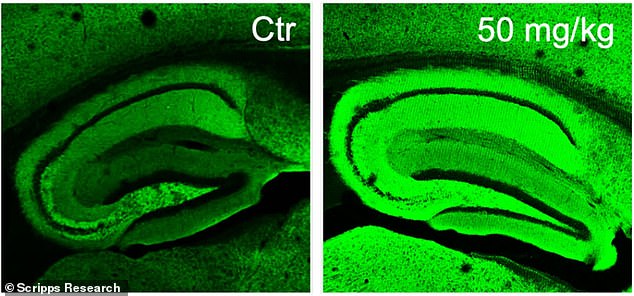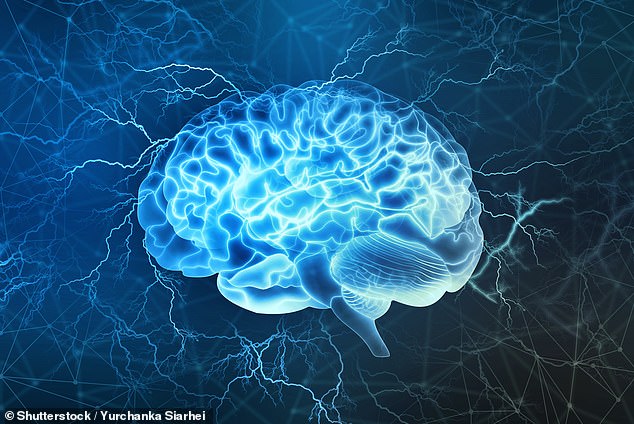A compound hiding inside rosemary and sage has been turned into a new treatment that may reverse Alzheimer’s disease.
Carnosic acid is antioxidant that has anti-inflammatory properties and is found in both of the herbs.
A team from the Scripps Research Institute in California discovered a way of harnessing the acid and using it to significantly lower inflammation in the brains of mice – a key trigger for Alzheimer’s.
The drug the team created using carnosic acid, diAcCA, not only extinguished the inflammation but also restored the healthy number of nerve cell connections in the brain that promote learning and memory.
Moreover, scientists said that since carnosic acid is already considered ‘safe’ by the US Food and Drug Administration, this new treatment will hopefully get fast-tracked to clinical trials – getting it to real Alzheimer’s patients sooner.
Alzheimer’s disease is the most common form of dementia, a condition generally known for its impact on the mind and memories of older adults.
Alzheimer’s is also the sixth leading cause of death in the US and more than 6.9 million Americans were living with the disease in 2024.
Not only do researchers believe this new treatment will potentially save lives, but diAcCA will likely do it without causing major side-effects.

In experiments with mice, scientists compared an Alzheimer’s-like brain (left) to ones treated with diAcCA, appearing as the more intense green color (right) because of the increased number of neuronal synapses — connections between nerve cells that underlie learning and memory

Herbs like rosemary and sage contain carnosic acid, which is an antioxidant that has anti-inflammatory properties that can ease Alzheimer’s-related damage in the brain
The new study, published in Antioxidants, revealed that diAcCA is only activated by the inflammation it’s trying to fight.
That means the carnosic acid-based treatment will only be active in areas of the brain suffering from inflammation, limiting any possible side-effects medications often have when they encounter healthy tissue – like cancer drugs.
Until now, it’s been extremely difficult to use carnosic acid as a drug or supplement because the compound is too unstable to use in its pure form.
The Scripps team created a derivative of the rosemary and sage compound that’s capable of reaching the gut before it breaks down.
Once there, diAcCA turns back into carnosic acid and it’s absorbed into the bloodstream.
Professor Stuart Lipton noted that the mice his team used in their experiments absorbed 20 percent more carnosic acid this way than they would have trying to ingest carnosic acid in its pure form.
This allowed more of the compound to pass through the blood-brain barrier and treat life-threatening pockets of brain inflammation.
Lipton added that this drug doesn’t just rid the brain of what’s driving Alzheimer’s disease, the mice taking it quickly regained the cognitive skills dementia affects.
‘We did multiple different tests of memory, and they were all improved with the drug,’ Lipton said in a statement.
‘It didn’t just slow down the decline; it improved virtually back to normal.’

The carnosic acid in sage is part of a new compound scientists have created, which delivers this acid to the bloodstream of Alzheimer’s patients more effectively

Alzheimer’s disease is the most common form of dementia, affecting nearly 7 million Americans over the age of 65
The researchers used a group of 45 mice, split into smaller bunches of seven or eight.
These weren’t just any mice – they were 5xFAD mice, bred to develop Alzheimer’s-like symptoms, including memory loss and brain damage, by the time they’re about five months-old.
Once reaching that age, the team gave them diAcCA or a placebo (olive oil) three times a week for three months.
They also tried three different doses – 10, 20, or 50 milligrams – to see what worked best.
After the three months, the scientists put the mice through a series of cognitive tests.
One was a water maze, where the mice swam in a pool to find a hidden platform they could stand on. Healthy mice get better at finding it over time, but Alzheimer’s mice struggle.
The team also conducted a fear test, where mice learn to freeze when they hear a sound linked to a mild shock, testing their memory of scary moments.
The team then looked inside the mice’s brains using special microscopes to see if the drug changed the harmful plaque buildups, protein tangles, or brain cell connections associated with Alzheimer’s.
The results were jaw-dropping. Mice given diAcCA, especially at the higher doses, swam to the platform faster and spent more time where it used to be, showing they remembered its spot better than the untreated Alzheimer’s mice.
In the fear test, they froze more often, proving their memory was sharper.
Under the microscope, their brains looked healthier too — displaying fewer plaques and tangles, more brain cell connections, and less inflammation.
‘By combating inflammation and oxidative stress with this diAcCA compound, we actually increased the number of synapses in the brain,’ Dr. Lipton added.
Although this isn’t a definitive cure for Alzheimer’s yet, researchers are extremely hopeful that what they’ve found in your kitchen herbs represents a major leap forward in treating dementia.
The team added that diAcCA may also make it possible for existing Alzheimer’s treatments to work better – by eliminating additional inflammation around the brain that usually hinders their effectiveness.






